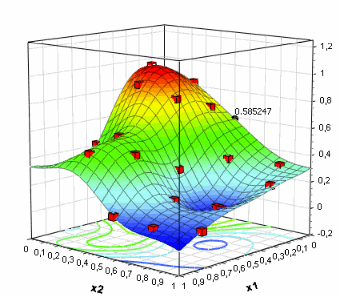Surrogate Models
In Design Manager, a surrogate is a predictive function that returns an estimated response value for a given set of numerical input parameters. Design Manager computes surrogate functions by fitting data from design study simulations to chosen surrogate models such as Kriging or Least Squares.
In statistics, there are various data interpolation methods for creating surrogate functions. An example of the Kriging method is shown below:

x1 and x2 are two input parameters used in the design study where the surrogate is created and computed. The red cubes represent the known response values obtained from design runs. The surface represents the calculated surrogate for this response. Using this surrogate, you can quickly predict a response value for any combination of x1 and x2 within the acceptable input range.
When valid surrogates are available, design studies that compute designs using surrogates run significantly faster than those that compute designs using simulations. In order to compute relevant surrogates, you must run one or more initial design studies that use simulations and cover an adequate design space. After computing surrogates, you can use them in other design studies or export them as Functional Mockup Units (FMUs) for use in other software tools. For more details of workflows, refer to Generating and Applying Surrogate Models.
- Kriging (default)
- Least Squares
- Radial Basis Function
For each design type, there are several parameters you can adjust to achieve an accurate surrogate modelling. For more details, refer to Surrogate Reference.
To assess the prediction accuracy of the computed surrogates, you investigate sample data sets—look at the outputs of the surrogate calculation and run a cross validation. For more details, refer to Assessing Surrogate Accuracy.
For examples of applications, refer to the following tutorials: